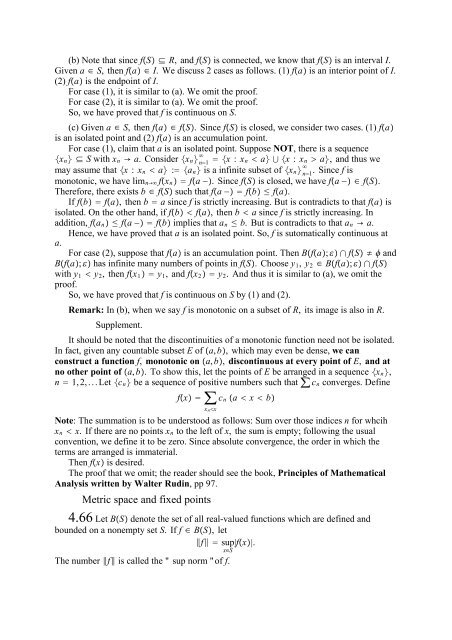The Real And Complex Number Systems
The Real And Complex Number Systems
The Real And Complex Number Systems
You also want an ePaper? Increase the reach of your titles
YUMPU automatically turns print PDFs into web optimized ePapers that Google loves.
(b) Note that since fS R, andfS is connected, we know that fS is an interval I.<br />
Given a S, then fa I. We discuss 2 cases as follows. (1) fa is an interior point of I.<br />
(2) fa is the endpoint of I.<br />
For case (1), it is similar to (a). We omit the proof.<br />
For case (2), it is similar to (a). We omit the proof.<br />
So, we have proved that f is continuous on S.<br />
(c) Given a S, then fa fS. SincefS is closed, we consider two cases. (1) fa<br />
is an isolated point and (2) fa is an accumulation point.<br />
For case (1), claim that a is an isolated point. Suppose NOT, there is a sequence<br />
<br />
x n S with x n a. Consider x n n1<br />
x : x n a x : x n a, and thus we<br />
may assume that x : x n a : a n is a infinite subset of x n <br />
n1<br />
.Sincef is<br />
monotonic, we have lim n fx n fa . SincefS is closed, we have fa fS.<br />
<strong>The</strong>refore, there exists b fS such that fa fb fa.<br />
If fb fa, then b a since f is strictly increasing. But is contradicts to that fa is<br />
isolated. On the other hand, if fb fa, then b a since f is strictly increasing. In<br />
addition, fa n fa fb implies that a n b. But is contradicts to that a n a.<br />
Hence, we have proved that a is an isolated point. So, f is sutomatically continuous at<br />
a.<br />
For case (2), suppose that fa is an accumulation point. <strong>The</strong>n Bfa; fS and<br />
Bfa; has infinite many numbers of points in fS. Choose y 1 , y 2 Bfa; fS<br />
with y 1 y 2 , then fx 1 y 1 ,andfx 2 y 2 . <strong>And</strong> thus it is similar to (a), we omit the<br />
proof.<br />
So, we have proved that f is continuous on S by (1) and (2).<br />
Remark: In (b), when we say f is monotonic on a subset of R, its image is also in R.<br />
Supplement.<br />
It should be noted that the discontinuities of a monotonic function need not be isolated.<br />
In fact, given any countable subset E of a, b, which may even be dense, we can<br />
construct a function f, monotonic on a, b, discontinuous at every point of E, and at<br />
no other point of a, b. To show this, let the points of E be arranged in a sequence x n ,<br />
n 1, 2, . . . Let c n be a sequence of positive numbers such that c n converges. Define<br />
fx c n a x b<br />
x nx<br />
Note: <strong>The</strong> summation is to be understood as follows: Sum over those indices n for whcih<br />
x n x. If there are no points x n to the left of x, the sum is empty; following the usual<br />
convention, we define it to be zero. Since absolute convergence, the order in which the<br />
terms are arranged is immaterial.<br />
<strong>The</strong>n fx is desired.<br />
<strong>The</strong> proof that we omit; the reader should see the book, Principles of Mathematical<br />
Analysis written by Walter Rudin, pp97.<br />
Metric space and fixed points<br />
4.66 Let BS denote the set of all real-valued functions which are defined and<br />
bounded on a nonempty set S. Iff BS, let<br />
f sup<br />
xS<br />
<strong>The</strong> number f is called the " sup norm " of f.<br />
|fx|.
















